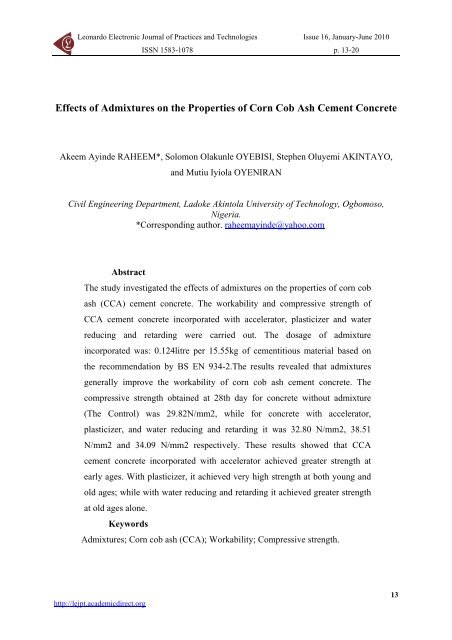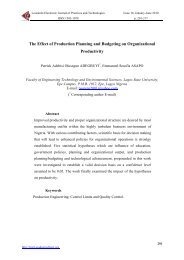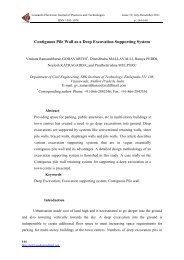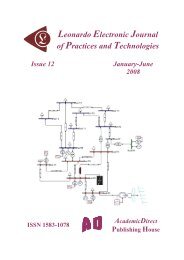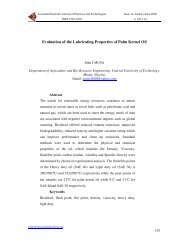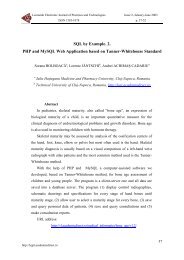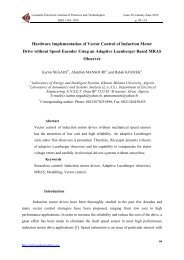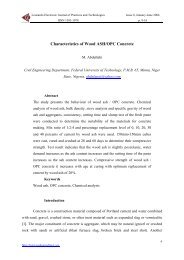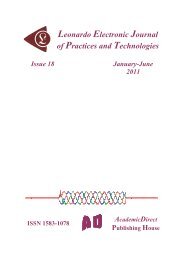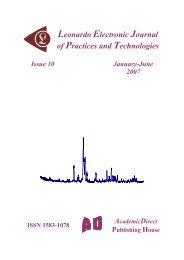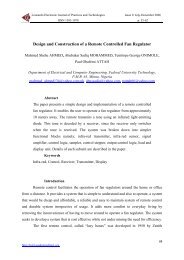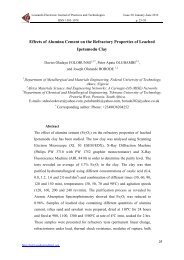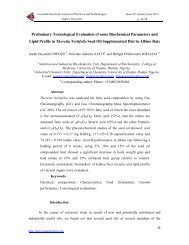Effects of Admixtures on the Properties of Corn Cob Ash Cement ...
Effects of Admixtures on the Properties of Corn Cob Ash Cement ...
Effects of Admixtures on the Properties of Corn Cob Ash Cement ...
You also want an ePaper? Increase the reach of your titles
YUMPU automatically turns print PDFs into web optimized ePapers that Google loves.
Le<strong>on</strong>ardo Electr<strong>on</strong>ic Journal <str<strong>on</strong>g>of</str<strong>on</strong>g> Practices and Technologies<br />
ISSN 1583-1078<br />
http://lejpt.academicdirect.org<br />
Issue 16, January-June 2010<br />
p. 13-20<br />
<str<strong>on</strong>g>Effects</str<strong>on</strong>g> <str<strong>on</strong>g>of</str<strong>on</strong>g> <str<strong>on</strong>g>Admixtures</str<strong>on</strong>g> <strong>on</strong> <strong>the</strong> <strong>Properties</strong> <str<strong>on</strong>g>of</str<strong>on</strong>g> <strong>Corn</strong> <strong>Cob</strong> <strong>Ash</strong> <strong>Cement</strong> C<strong>on</strong>crete<br />
Akeem Ayinde RAHEEM*, Solom<strong>on</strong> Olakunle OYEBISI, Stephen Oluyemi AKINTAYO,<br />
and Mutiu Iyiola OYENIRAN<br />
Civil Engineering Department, Ladoke Akintola University <str<strong>on</strong>g>of</str<strong>on</strong>g> Technology, Ogbomoso,<br />
Nigeria.<br />
*Corresp<strong>on</strong>ding author. raheemayinde@yahoo.com<br />
Abstract<br />
The study investigated <strong>the</strong> effects <str<strong>on</strong>g>of</str<strong>on</strong>g> admixtures <strong>on</strong> <strong>the</strong> properties <str<strong>on</strong>g>of</str<strong>on</strong>g> corn cob<br />
ash (CCA) cement c<strong>on</strong>crete. The workability and compressive strength <str<strong>on</strong>g>of</str<strong>on</strong>g><br />
CCA cement c<strong>on</strong>crete incorporated with accelerator, plasticizer and water<br />
reducing and retarding were carried out. The dosage <str<strong>on</strong>g>of</str<strong>on</strong>g> admixture<br />
incorporated was: 0.124litre per 15.55kg <str<strong>on</strong>g>of</str<strong>on</strong>g> cementitious material based <strong>on</strong><br />
<strong>the</strong> recommendati<strong>on</strong> by BS EN 934-2.The results revealed that admixtures<br />
generally improve <strong>the</strong> workability <str<strong>on</strong>g>of</str<strong>on</strong>g> corn cob ash cement c<strong>on</strong>crete. The<br />
compressive strength obtained at 28th day for c<strong>on</strong>crete without admixture<br />
(The C<strong>on</strong>trol) was 29.82N/mm2, while for c<strong>on</strong>crete with accelerator,<br />
plasticizer, and water reducing and retarding it was 32.80 N/mm2, 38.51<br />
N/mm2 and 34.09 N/mm2 respectively. These results showed that CCA<br />
cement c<strong>on</strong>crete incorporated with accelerator achieved greater strength at<br />
early ages. With plasticizer, it achieved very high strength at both young and<br />
old ages; while with water reducing and retarding it achieved greater strength<br />
at old ages al<strong>on</strong>e.<br />
Keywords<br />
<str<strong>on</strong>g>Admixtures</str<strong>on</strong>g>; <strong>Corn</strong> cob ash (CCA); Workability; Compressive strength.<br />
13
14<br />
<str<strong>on</strong>g>Effects</str<strong>on</strong>g> <str<strong>on</strong>g>of</str<strong>on</strong>g> <str<strong>on</strong>g>Admixtures</str<strong>on</strong>g> <strong>on</strong> <strong>the</strong> <strong>Properties</strong> <str<strong>on</strong>g>of</str<strong>on</strong>g> <strong>Corn</strong> <strong>Cob</strong> <strong>Ash</strong> <strong>Cement</strong> C<strong>on</strong>crete<br />
Akeem A. RAHEEM, Solom<strong>on</strong> O. OYEBISI, Stephen O. AKINTAYO, and Mutiu I. OYENIRAN<br />
Introducti<strong>on</strong><br />
<str<strong>on</strong>g>Admixtures</str<strong>on</strong>g> are substances introduced into a batch <str<strong>on</strong>g>of</str<strong>on</strong>g> c<strong>on</strong>crete, during or immediately<br />
before its mixing, in order to alter or improve <strong>the</strong> properties <str<strong>on</strong>g>of</str<strong>on</strong>g> <strong>the</strong> fresh or hardened c<strong>on</strong>crete<br />
or both. According to Neil and Ravindra [1], numerous benefits are available through <strong>the</strong> use<br />
<str<strong>on</strong>g>of</str<strong>on</strong>g> admixtures such as: improved quality, accelerati<strong>on</strong> or retardati<strong>on</strong> <str<strong>on</strong>g>of</str<strong>on</strong>g> setting time, coloring,<br />
greater c<strong>on</strong>crete strength, increased flow for <strong>the</strong> same water-to-cement ratio, enhanced frost<br />
and sulfate resistance, improved fire resistance, cracking c<strong>on</strong>trol, lower density, improved<br />
workability and enhanced finishability. The changes brought about in c<strong>on</strong>crete by <strong>the</strong> use <str<strong>on</strong>g>of</str<strong>on</strong>g><br />
admixtures are affected through <strong>the</strong> influence <str<strong>on</strong>g>of</str<strong>on</strong>g> <strong>the</strong> admixtures <strong>on</strong> hydrati<strong>on</strong>, liberati<strong>on</strong> <str<strong>on</strong>g>of</str<strong>on</strong>g><br />
heat, formati<strong>on</strong> <str<strong>on</strong>g>of</str<strong>on</strong>g> pores and <strong>the</strong> development <str<strong>on</strong>g>of</str<strong>on</strong>g> <strong>the</strong> gel structure [2]. The specific effects <str<strong>on</strong>g>of</str<strong>on</strong>g><br />
an admixture generally vary with <strong>the</strong> type <str<strong>on</strong>g>of</str<strong>on</strong>g> cement, mix proporiti<strong>on</strong>, ambient c<strong>on</strong>diti<strong>on</strong>s<br />
(particularly temperature) and dosage.<br />
<strong>Corn</strong> cob is <strong>the</strong> agricultural waste product obtained from maize or corn, which is <strong>the</strong><br />
most important cereal crop in sub-Saharan Africa. According to Food and Agriculture<br />
Organisati<strong>on</strong> (FAO) data, 589 milli<strong>on</strong> t<strong>on</strong>nes <str<strong>on</strong>g>of</str<strong>on</strong>g> maize were produced worldwide in <strong>the</strong> year<br />
2000 [3]. The United States was <strong>the</strong> largest maize producer having 43% <str<strong>on</strong>g>of</str<strong>on</strong>g> world producti<strong>on</strong>.<br />
Africa produced 7% <str<strong>on</strong>g>of</str<strong>on</strong>g> <strong>the</strong> world’s maize [4]. Nigeria was <strong>the</strong> sec<strong>on</strong>d largest producer <str<strong>on</strong>g>of</str<strong>on</strong>g><br />
maize in Africa in <strong>the</strong> year 2001 with 4.62 milli<strong>on</strong> t<strong>on</strong>ne. South Africa has <strong>the</strong> highest<br />
producti<strong>on</strong> <str<strong>on</strong>g>of</str<strong>on</strong>g> 8.04 milli<strong>on</strong> t<strong>on</strong>ne [3].<br />
There had been various research efforts <strong>on</strong> <strong>the</strong> use <str<strong>on</strong>g>of</str<strong>on</strong>g> corn cob ash (CCA) as a<br />
pozzolan in blended cement c<strong>on</strong>crete. Ogunfolami [5] c<strong>on</strong>sidered mixing <str<strong>on</strong>g>of</str<strong>on</strong>g> <strong>the</strong> CCA with<br />
Ordinary Portland <strong>Cement</strong> at <strong>the</strong> point <str<strong>on</strong>g>of</str<strong>on</strong>g> need i. e. <strong>on</strong> site. Adesanya and Raheem [6] studied<br />
<strong>the</strong> use <str<strong>on</strong>g>of</str<strong>on</strong>g> CCA blended cement produced in <strong>the</strong> c<strong>on</strong>trolled envir<strong>on</strong>ment <str<strong>on</strong>g>of</str<strong>on</strong>g> a factory as<br />
reported by [7], to produce c<strong>on</strong>crete specimens. Both studies c<strong>on</strong>cluded that <strong>the</strong> compressive<br />
strength <str<strong>on</strong>g>of</str<strong>on</strong>g> <strong>the</strong> CCA-blended cement c<strong>on</strong>crete is lower than that <str<strong>on</strong>g>of</str<strong>on</strong>g> plain c<strong>on</strong>crete (<strong>the</strong> c<strong>on</strong>trol)<br />
at early curing ages but improves significantly at later ages ( after 90 days). Thus, <strong>the</strong>re is<br />
need to look for ways <str<strong>on</strong>g>of</str<strong>on</strong>g> increasing <strong>the</strong> strength at early ages. This study investigated <strong>the</strong><br />
incorporati<strong>on</strong> <str<strong>on</strong>g>of</str<strong>on</strong>g> admixtures into CCA blended cement c<strong>on</strong>crete with a view to enhancing its<br />
suitability as a structural material.<br />
<str<strong>on</strong>g>Admixtures</str<strong>on</strong>g> are comm<strong>on</strong>ly classified by <strong>the</strong>ir functi<strong>on</strong>s in c<strong>on</strong>crete into seven types, as<br />
specified in ASTM C 494 (1992) [8] viz:
Le<strong>on</strong>ardo Electr<strong>on</strong>ic Journal <str<strong>on</strong>g>of</str<strong>on</strong>g> Practices and Technologies<br />
ISSN 1583-1078<br />
Issue 16, January-June 2010<br />
p. 13-20<br />
Type A Water reducing<br />
Type B Retarding<br />
Type C- Accelerating<br />
Type D Water – Reducing and Retarding<br />
Type E Water-Reducing and Accelerating<br />
Type F High-range water-reducing or Superplaticizing<br />
Type G High-range water-reducing and Retarding or Superplastcizing and<br />
retarding<br />
For <strong>the</strong> purpose <str<strong>on</strong>g>of</str<strong>on</strong>g> this study, Type C (Accelerating <str<strong>on</strong>g>Admixtures</str<strong>on</strong>g>), Type D (Water<br />
reducing and retarding Admixture), and Type F (Superplasticizing <str<strong>on</strong>g>Admixtures</str<strong>on</strong>g>) were<br />
c<strong>on</strong>sidered.<br />
Experimental Procedure<br />
Materials<br />
The CCA blended cement used was produced in accordance with <strong>the</strong> procedure set out<br />
in [7]. The chemical compositi<strong>on</strong> <str<strong>on</strong>g>of</str<strong>on</strong>g> CCA [as obtained from previous study (7)], which makes<br />
it possible to be used as a pozzolan, is presented in Table 1. Sharp sand was used as fine<br />
aggregates and granite as coarse aggregates. The fine and coarse aggregates used were<br />
obtained from Ogbomoso, Nigeria. The grading curve for <strong>the</strong> sharp sand used is shown in<br />
Figure 1 while that <str<strong>on</strong>g>of</str<strong>on</strong>g> <strong>the</strong> granite is shown in Figure 2. The admixtures used are: Accelerator<br />
[Pozzolith 555], Water Reducing and Retarder (C<strong>on</strong>plast RP264) and Superplasticizer (SP-3).<br />
Table 1. Chemical compositi<strong>on</strong> <str<strong>on</strong>g>of</str<strong>on</strong>g> corn cob ash (CCA)<br />
Chemical C<strong>on</strong>stituents<br />
Compositi<strong>on</strong> (%)<br />
Sample 1 Sample 2 Sample 2 Average<br />
SiO2 67.33 65.39 66.41 66.38<br />
Al2O3 7.34 9.14 5.97 7.48<br />
Fe2O3 3.74 5.61 3.97 4.44<br />
CaO 10.29 12.89 11.53 11.57<br />
MgO 1.82 2.33 2.02 2.06<br />
SO3 1.11 1.10 1.01 1.07<br />
Na2O 0.39 0.48 0.36 0.41<br />
K2O 4.20 4.92 5.64 4.92<br />
S1O2 + Al2O3 74.67 74.53 72.38 73.86<br />
15
16<br />
Percentage Passing (%)<br />
Percentage Passing (%)<br />
<str<strong>on</strong>g>Effects</str<strong>on</strong>g> <str<strong>on</strong>g>of</str<strong>on</strong>g> <str<strong>on</strong>g>Admixtures</str<strong>on</strong>g> <strong>on</strong> <strong>the</strong> <strong>Properties</strong> <str<strong>on</strong>g>of</str<strong>on</strong>g> <strong>Corn</strong> <strong>Cob</strong> <strong>Ash</strong> <strong>Cement</strong> C<strong>on</strong>crete<br />
Akeem A. RAHEEM, Solom<strong>on</strong> O. OYEBISI, Stephen O. AKINTAYO, and Mutiu I. OYENIRAN<br />
100<br />
90<br />
80<br />
70<br />
60<br />
50<br />
40<br />
30<br />
20<br />
10<br />
0<br />
0.01 0.1 1 10<br />
Sieve Size (mm)<br />
Figure 1. Particle size analysis for <strong>the</strong> sharp sand used<br />
100<br />
90<br />
80<br />
70<br />
60<br />
50<br />
40<br />
30<br />
20<br />
10<br />
0<br />
1 10<br />
Sieve Sizes (mm)<br />
Figure 2. Grading curve for <strong>the</strong> granite used<br />
Specimen Preparati<strong>on</strong><br />
The weight method <str<strong>on</strong>g>of</str<strong>on</strong>g> batching was adopted throughout. The mix ratio for <strong>the</strong><br />
c<strong>on</strong>crete is 1: 2: 4 and <strong>the</strong> dimensi<strong>on</strong> <str<strong>on</strong>g>of</str<strong>on</strong>g> mould is 150mm × 150mm × 150mm. The CCA was<br />
8% by weight <str<strong>on</strong>g>of</str<strong>on</strong>g> cement used since a previous study [6] reported that <strong>the</strong> optimum level <str<strong>on</strong>g>of</str<strong>on</strong>g><br />
CCA replacement from structural load viewpoint is 8%. The dosages <str<strong>on</strong>g>of</str<strong>on</strong>g> admixtures<br />
incorporated were: 0.124 litre <str<strong>on</strong>g>of</str<strong>on</strong>g> accelerator, water reducing and retarder and plasticizer per<br />
15.55kg <str<strong>on</strong>g>of</str<strong>on</strong>g> cementitious material based <strong>on</strong> <strong>the</strong> recommendati<strong>on</strong> by BS EN 934 -2 [9].
Le<strong>on</strong>ardo Electr<strong>on</strong>ic Journal <str<strong>on</strong>g>of</str<strong>on</strong>g> Practices and Technologies<br />
ISSN 1583-1078<br />
Issue 16, January-June 2010<br />
p. 13-20<br />
The required quantity <str<strong>on</strong>g>of</str<strong>on</strong>g> cement and corncob ash were first mixed <strong>the</strong>n, sharp sand<br />
was added and thoroughly mixed until a uniform distributi<strong>on</strong> was obtained. Granite was <strong>the</strong>n<br />
added and mixed until a fairly uniform appearance was observed. Water was gradually added<br />
and <strong>the</strong> mix was thoroughly mixed until uniform appearance in colour and c<strong>on</strong>sistency was<br />
obtained. This served as <strong>the</strong> c<strong>on</strong>trol experiment. For <strong>the</strong> o<strong>the</strong>r experiments, <strong>the</strong> above<br />
procedure was repeated until when water is to be introduced. Water, toge<strong>the</strong>r with <strong>the</strong><br />
required dosage <str<strong>on</strong>g>of</str<strong>on</strong>g> each admixture was <strong>the</strong>n added and <strong>the</strong> composites thoroughly mixed until<br />
uniform colour and c<strong>on</strong>sistency was obtained. C<strong>on</strong>stant water/ cementitious material ratio <str<strong>on</strong>g>of</str<strong>on</strong>g><br />
0.55 was adopted throughout.<br />
Testing Procedure<br />
Slump test was carried out to check <strong>the</strong> effects <str<strong>on</strong>g>of</str<strong>on</strong>g> admixtures <strong>on</strong> <strong>the</strong> workability <str<strong>on</strong>g>of</str<strong>on</strong>g><br />
corn cob ash cement c<strong>on</strong>crete. The test was carried out in accordance with <strong>the</strong> requirements <str<strong>on</strong>g>of</str<strong>on</strong>g><br />
BS 1881: Part 102 (1983) [10]. For compressive strength test, a total <str<strong>on</strong>g>of</str<strong>on</strong>g> 60 cubes were cast for<br />
<strong>the</strong> four experiments. After casting, <strong>the</strong> specimens were stored in <strong>the</strong> curing room at 27 ± 5 o C<br />
with 90% relative humidity for 24hours and <strong>the</strong>n demoulded and placed under water until <strong>the</strong><br />
testing ages <str<strong>on</strong>g>of</str<strong>on</strong>g> 1, 3, 7, 14 and 28 days. The compressive strength was determined with<br />
CONTEST Compressive Strength Testing Machine (Type GDIOA, Serial Number 3688) with<br />
maximum capacity <str<strong>on</strong>g>of</str<strong>on</strong>g> 2000KN. The strength value was <strong>the</strong> average <str<strong>on</strong>g>of</str<strong>on</strong>g> three specimens.<br />
Results and Discussi<strong>on</strong><br />
Workability<br />
The results <str<strong>on</strong>g>of</str<strong>on</strong>g> <strong>the</strong> slump for <strong>the</strong> four classes <str<strong>on</strong>g>of</str<strong>on</strong>g> corn cob ash cement c<strong>on</strong>crete are<br />
shown in Table 2.<br />
Table 2. Slump Test Results<br />
Class <str<strong>on</strong>g>of</str<strong>on</strong>g> C<strong>on</strong>crete Slump (mm)<br />
C<strong>on</strong>crete without Admixture 28.5<br />
C<strong>on</strong>crete with water reducing and retarder 29.6<br />
C<strong>on</strong>crete with Accelerator 32.4<br />
C<strong>on</strong>crete with Plasticizer 35.5<br />
17
18<br />
<str<strong>on</strong>g>Effects</str<strong>on</strong>g> <str<strong>on</strong>g>of</str<strong>on</strong>g> <str<strong>on</strong>g>Admixtures</str<strong>on</strong>g> <strong>on</strong> <strong>the</strong> <strong>Properties</strong> <str<strong>on</strong>g>of</str<strong>on</strong>g> <strong>Corn</strong> <strong>Cob</strong> <strong>Ash</strong> <strong>Cement</strong> C<strong>on</strong>crete<br />
Akeem A. RAHEEM, Solom<strong>on</strong> O. OYEBISI, Stephen O. AKINTAYO, and Mutiu I. OYENIRAN<br />
The table indicates that <strong>the</strong> c<strong>on</strong>crete slump increases with <strong>the</strong> incorporati<strong>on</strong> <str<strong>on</strong>g>of</str<strong>on</strong>g><br />
admixtures. While <strong>the</strong> c<strong>on</strong>trol has a slump <str<strong>on</strong>g>of</str<strong>on</strong>g> 28.5mm, c<strong>on</strong>crete with Water reducing and<br />
retarder, Accelerator and Plasticizer has slump <str<strong>on</strong>g>of</str<strong>on</strong>g> 29.6mm, 32.4mm and 35.5mm respectively.<br />
This finding is in agreement with <strong>the</strong> report <str<strong>on</strong>g>of</str<strong>on</strong>g> Kosmatka et al. (2003) [11] which stated that<br />
adding an admixture to c<strong>on</strong>crete without reducing <strong>the</strong> water c<strong>on</strong>tent (i.e. with c<strong>on</strong>stant w/c<br />
ratio) can produce a mixture with a higher slump.These results indicate that admixtures<br />
generally improve <strong>the</strong> workability <str<strong>on</strong>g>of</str<strong>on</strong>g> corn cob ash cement c<strong>on</strong>crete. The greatest effect was<br />
caused by <strong>the</strong> plasticizer. This is due to <strong>the</strong> fact that it improves <strong>the</strong> flow properties <str<strong>on</strong>g>of</str<strong>on</strong>g> <strong>the</strong> mix<br />
by dispersing <strong>the</strong> cement particles and breaking up cement agglomerate.<br />
Compressive Strength<br />
The results <str<strong>on</strong>g>of</str<strong>on</strong>g> <strong>the</strong> compressive strength <str<strong>on</strong>g>of</str<strong>on</strong>g> corn cob ash cement c<strong>on</strong>crete are presented<br />
in Table 3. The compressive strengths obtained at 1 st , 3 rd , 7 th , 14 th and 28 th days for c<strong>on</strong>crete<br />
cubes without Admixture (The C<strong>on</strong>trol) were 10.42 N/mm 2 , 12.71 N/mm 2 , 15.30 N/mm 2 ,<br />
21.85 N/mm 2 , and 29.82 N/mm 2 respectively. For c<strong>on</strong>crete cubes with Accelerator, <strong>the</strong>y were<br />
13.19 N/mm 2 , 15.40 N/mm 2 , 17.33 N/mm 2 , 24.89 N/mm 2 and 32.80 N/mm 2 respectively. For<br />
c<strong>on</strong>crete cubes with Plasticizer, <strong>the</strong>y were 15.31 N/mm 2 , 17.42 N/mm 2 , 19.56 N/mm 2 , 27.84<br />
N/mm 2 and 38.51 N/mm 2 respectively and for c<strong>on</strong>crete cubes with Water reducing and<br />
retarder <strong>the</strong>y were 12.07 N/mm 2 , 15.39 N/mm 2 , 17.88 N/mm 2 , 25.78 N/mm 2 , and 34.09<br />
N/mm 2 respectively. The NIS 439:2000 [12] requirements for minimum compressive<br />
strength <str<strong>on</strong>g>of</str<strong>on</strong>g> 26Nmm -2 at 28 days were satisfied by all <strong>the</strong> classes <str<strong>on</strong>g>of</str<strong>on</strong>g> c<strong>on</strong>crete. The<br />
incorporati<strong>on</strong> <str<strong>on</strong>g>of</str<strong>on</strong>g> admixtures in corn cob ash cement c<strong>on</strong>crete generally improves its<br />
compressive strength at all ages irrespective <str<strong>on</strong>g>of</str<strong>on</strong>g> <strong>the</strong> type used.<br />
Table 3. Summary <str<strong>on</strong>g>of</str<strong>on</strong>g> Compressive Strength Test Results<br />
Class <str<strong>on</strong>g>of</str<strong>on</strong>g> C<strong>on</strong>crete 1 Day<br />
(N/mm 2 )<br />
3 Days<br />
(N/mm 2 )<br />
7 Days<br />
(N/mm 2 )<br />
14 Days<br />
(N/mm 2 )<br />
28 Days<br />
(N/mm 2 C<strong>on</strong>crete Cube without Admixture 10.42 12.71 15.30 21.85<br />
)<br />
29.82<br />
C<strong>on</strong>crete Cube with Accelerator 13.19 15.40 17.33 24.89 32.80<br />
C<strong>on</strong>crete Cube with Plasticizer 15.31 17.42 19.56 27.84 38.51<br />
C<strong>on</strong>crete Cube with Water reducing and Retarder 12.07 15.29 17.88 25.78 34.09<br />
When compared with <strong>the</strong> c<strong>on</strong>trol, <strong>the</strong> corn cob ash cement c<strong>on</strong>crete incorporated with<br />
Accelerator has an increase in compressive strength <str<strong>on</strong>g>of</str<strong>on</strong>g> 26.6% at day 1, 21.2% at day 3, 13.3%<br />
at day 7, 13 9% at day 14 and 10% at 28 days. This is because, accelerator increases <strong>the</strong>
Le<strong>on</strong>ardo Electr<strong>on</strong>ic Journal <str<strong>on</strong>g>of</str<strong>on</strong>g> Practices and Technologies<br />
ISSN 1583-1078<br />
Issue 16, January-June 2010<br />
p. 13-20<br />
hydrati<strong>on</strong> <str<strong>on</strong>g>of</str<strong>on</strong>g> <strong>the</strong> cement and depresses <strong>the</strong> freezing point <str<strong>on</strong>g>of</str<strong>on</strong>g> c<strong>on</strong>crete by no more than 2 0 C<br />
which speed up <strong>the</strong> setting and rate <str<strong>on</strong>g>of</str<strong>on</strong>g> strength gain <strong>the</strong>reby making <strong>the</strong> c<strong>on</strong>crete str<strong>on</strong>ger.<br />
This is in line with <strong>the</strong> findings <str<strong>on</strong>g>of</str<strong>on</strong>g> Neville (1996) [13]. The effect is more pr<strong>on</strong>ounced at early<br />
ages as higher percentages <str<strong>on</strong>g>of</str<strong>on</strong>g> strength gains were recorded at day 1 and day 3.<br />
For corn cob ash cement c<strong>on</strong>crete incorporated with Water reducing and retarder, an<br />
increase in compressive strength <str<strong>on</strong>g>of</str<strong>on</strong>g> 15.8% at day 1, 20.3% at day 3, 16.9% at day 18.0% at<br />
day 14 and 14.3% at 28 days were recorded over that <str<strong>on</strong>g>of</str<strong>on</strong>g> <strong>the</strong> c<strong>on</strong>trol. This result is supported<br />
by Kosmatka et al. (2003) [11], which noted that for c<strong>on</strong>cretes <str<strong>on</strong>g>of</str<strong>on</strong>g> equal cement c<strong>on</strong>tent, <strong>the</strong> 28<br />
day strength <str<strong>on</strong>g>of</str<strong>on</strong>g> c<strong>on</strong>crete with water reducing admixture can be 10% to 25% greater than<br />
c<strong>on</strong>crete without admixture. The strength gains recorded in this study for all testing ages, fall<br />
within <strong>the</strong> specified range <str<strong>on</strong>g>of</str<strong>on</strong>g> 10% to 25%. Lower strength gains were witnessed at early ages<br />
(day 1 and 3) while higher strength gains were recorded at later ages (day 7, 14. and 28).<br />
With corn cob ash cement c<strong>on</strong>crete having Plasticizer as admixture, an increase in<br />
compressive strength <str<strong>on</strong>g>of</str<strong>on</strong>g> 46.9% at day 1, 37.1% at day 3, 27.8% at day 7, 27.4% at day 14 and<br />
29.1% at 28 days were observed over that <str<strong>on</strong>g>of</str<strong>on</strong>g> <strong>the</strong> c<strong>on</strong>trol. This showed higher percentage<br />
strength increases at early and later ages when compared with <strong>the</strong> results for Accelerating and<br />
Water reducing and retarding admixtures.<br />
C<strong>on</strong>clusi<strong>on</strong>s<br />
From <strong>the</strong> results <str<strong>on</strong>g>of</str<strong>on</strong>g> <strong>the</strong> various tests performed, <strong>the</strong> following c<strong>on</strong>clusi<strong>on</strong>s can be<br />
drawn:<br />
1. <str<strong>on</strong>g>Admixtures</str<strong>on</strong>g> generally improve <strong>the</strong> workability <str<strong>on</strong>g>of</str<strong>on</strong>g> corn cob ash cement c<strong>on</strong>crete. The<br />
greatest effect was caused by plasticizer which improves <strong>the</strong> flow properties <str<strong>on</strong>g>of</str<strong>on</strong>g> <strong>the</strong> mix by<br />
dispersing <strong>the</strong> cement particles and breaking up cement agglomerate.<br />
2. The incorporati<strong>on</strong> <str<strong>on</strong>g>of</str<strong>on</strong>g> admixtures in corn cob ash cement c<strong>on</strong>crete generally increases its<br />
compressive strength at all ages irrespective <str<strong>on</strong>g>of</str<strong>on</strong>g> <strong>the</strong> type used.<br />
3. The use <str<strong>on</strong>g>of</str<strong>on</strong>g> Accelerator achieved greater strength at early ages. With Plasticizer, high<br />
strength was achieved at both young and old ages while with Water reducing and retarder,<br />
greater strength was achieved at old ages al<strong>on</strong>e.<br />
19
20<br />
<str<strong>on</strong>g>Effects</str<strong>on</strong>g> <str<strong>on</strong>g>of</str<strong>on</strong>g> <str<strong>on</strong>g>Admixtures</str<strong>on</strong>g> <strong>on</strong> <strong>the</strong> <strong>Properties</strong> <str<strong>on</strong>g>of</str<strong>on</strong>g> <strong>Corn</strong> <strong>Cob</strong> <strong>Ash</strong> <strong>Cement</strong> C<strong>on</strong>crete<br />
Akeem A. RAHEEM, Solom<strong>on</strong> O. OYEBISI, Stephen O. AKINTAYO, and Mutiu I. OYENIRAN<br />
Acknowledgements<br />
The authors acknowledge <strong>the</strong> staff <str<strong>on</strong>g>of</str<strong>on</strong>g> Central Engineering Laboratory, Reynolds<br />
C<strong>on</strong>structi<strong>on</strong> Company, Ilorin; for <strong>the</strong> opportunity given to perform <strong>the</strong> various laboratory<br />
tests using <strong>the</strong>ir facilities.<br />
References<br />
1. Neil J., Ravindra K.D., Civil Engineering Materials, 5 th editi<strong>on</strong>, England, L<strong>on</strong>gman, 1996.<br />
2. Jacks<strong>on</strong> N., Dhir R.K., Civil Engineering Material, L<strong>on</strong>d<strong>on</strong>, Macmillan, 1996.<br />
3. FAO. Records, Retrieved December 15, 2002, Available at: http://apps.fao.org/default.htm.<br />
4. IITA. Maize, Retrieved December 15, 2002, Available at:<br />
http://intranet/iita4/crop/maize.htm.<br />
5. Ogunfolaji T.F., The Effect Of Thermal C<strong>on</strong>ductivity and Chemical Attack <strong>on</strong> <strong>Corn</strong> <strong>Cob</strong><br />
<strong>Ash</strong> <strong>Cement</strong> C<strong>on</strong>crete, Unpublished B. Sc. Project Report, Department <str<strong>on</strong>g>of</str<strong>on</strong>g> Building,<br />
Obafemi Awolowo University, Ile-Ife, 1995.<br />
6. Adesanya D.A., Raheem A.A., A study <str<strong>on</strong>g>of</str<strong>on</strong>g> <strong>the</strong> workability and compressive strength<br />
characteristics <str<strong>on</strong>g>of</str<strong>on</strong>g> corn cob ash blended cement c<strong>on</strong>crete, C<strong>on</strong>structi<strong>on</strong> and Building<br />
Materials, 2009, 23, p. 311-317.<br />
7. Adesanya D.A., Raheem A.A., Development <str<strong>on</strong>g>of</str<strong>on</strong>g> <strong>Corn</strong> <strong>Cob</strong> <strong>Ash</strong> Blended <strong>Cement</strong>,<br />
C<strong>on</strong>structi<strong>on</strong> and Building Materials, 2009, 23, p.347-352.<br />
8. American Society for Testing and Materials. Specificati<strong>on</strong> for Chemical <str<strong>on</strong>g>Admixtures</str<strong>on</strong>g> for<br />
C<strong>on</strong>crete, ASTM C 494, 1992.<br />
9. British Standard Instituti<strong>on</strong>. <str<strong>on</strong>g>Admixtures</str<strong>on</strong>g> for C<strong>on</strong>crete, Mortar and Grouting, BS EN934 -<br />
2, L<strong>on</strong>d<strong>on</strong>, British Standard Instituti<strong>on</strong>, 2001.<br />
10. British Standard Instituti<strong>on</strong>. Methods for determinati<strong>on</strong> <str<strong>on</strong>g>of</str<strong>on</strong>g> Slump, BS 1881: Part 102,<br />
L<strong>on</strong>d<strong>on</strong>, British Standard Instituti<strong>on</strong>, 1983.<br />
11. Kosmatka S.H., Kerkh<str<strong>on</strong>g>of</str<strong>on</strong>g>f B., Panarese W.C., Design and C<strong>on</strong>trol <str<strong>on</strong>g>of</str<strong>on</strong>g> C<strong>on</strong>crete Mixtures,<br />
EB001, 14 th editi<strong>on</strong>, Skokie, Illinois, USA, Portland <strong>Cement</strong> Associati<strong>on</strong>, 2003.<br />
12. Standards Organisati<strong>on</strong> <str<strong>on</strong>g>of</str<strong>on</strong>g> Nigeria. Standard for <strong>Cement</strong>, NIS 439, Lagos, Nigeria. 2000.<br />
13. Neville A.M., <strong>Properties</strong> <str<strong>on</strong>g>of</str<strong>on</strong>g> C<strong>on</strong>crete, 4 th editi<strong>on</strong>, L<strong>on</strong>d<strong>on</strong>, Pitman Publishers Inc., 1996.


